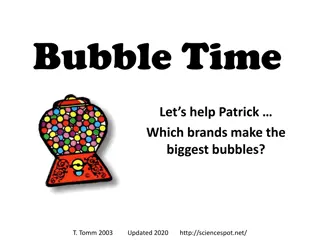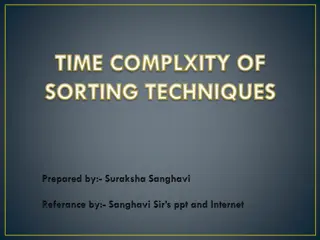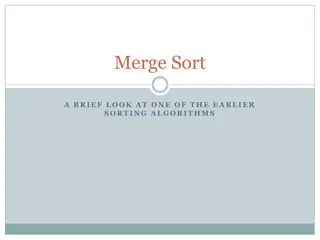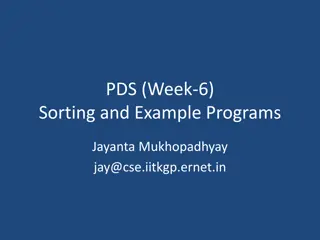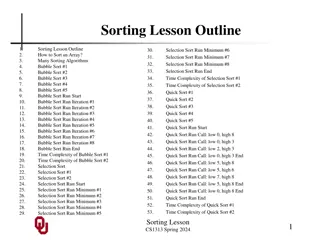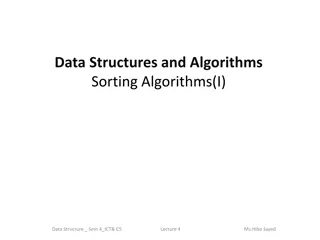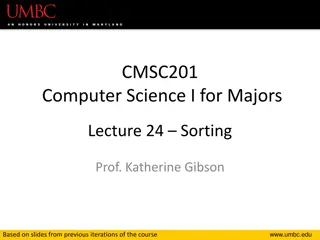Exploring Bubble Sort Algorithm for Teaching Computing Concepts
Dive into the world of sort algorithms with a focus on bubble sort, its efficiency, and computational thinking. Discover practical ways to teach computing concepts in a fun and engaging manner. Explore the process of bubble sort, learn how to compare and swap array elements, and understand the importance of multiple passes for sorting success.
Download Presentation

Please find below an Image/Link to download the presentation.
The content on the website is provided AS IS for your information and personal use only. It may not be sold, licensed, or shared on other websites without obtaining consent from the author. Download presentation by click this link. If you encounter any issues during the download, it is possible that the publisher has removed the file from their server.
E N D
Presentation Transcript
Bubble Sort Paul Curzon Queen Mary University of London CAS London With support from Google, BCS, Dept for Education the Mayor of London www.teachinglondoncomputing.org Twitter: @TeachingLDNComp
Aims Give you deeper understanding of core topics Sort algorithms including bubble sort Efficiency of algorithms Computational thinking Give you practical ways to teach computing in a fun, thought provoking way away from computers, focus on concepts Linked activity sheets and booklets can be downloaded from our website: www.teachinglondoncomputing.org
Sort Algorithms A sort algorithm takes an array of data and puts it into order (either ascending order or descending order) eg [5, 7, 2, 99, 4] -> [2, 4, 5, 7, 99] [ cat , hat , ant ] -> [ ant , cat , hat ] Often used as a way of making things easier to find (eg in a telephone directory) There are many sort algorithms some more efficient than others www.teachinglondoncomputing.org
Towards bubble sort Compare adjacent entries We can compare entries at a given position and swap them IF (array[position] > array [position+1]) THEN swap (array, position, position+1) 1
Towards bubble sort We can scan down the array doing that on adjacent pairs FOR position = 0 TO 3 { IF (array[position] > array [position+1]) THEN swap (array, position, position+1) } Is that enough to guarantee the array is sorted? 1
How many times do we do this We need to stop just before the end as the end entry has nothing to compare with So for an array of length 5, the last comparison is at position 4, to compare the 4th and 5th entries. However positions in arrays in many languages are numbered from 0 not 1 So that means it finishes comparing array[3] with array[4] www.teachinglondoncomputing.org
Towards bubble sort Multiple passes We need multiple passes i.e. to do that repeatedly FOR pass = 0 TO 3 { FOR position = 0 TO 3 { IF (array[position] > array [position+1]) THEN swap (array, position, position+1) } }
How many passes How many passes do we need to do to guarantee it is sorted? What is the worst situation we could be in? www.teachinglondoncomputing.org
How many passes On the first pass, the biggest value has ended up in the right place We took it with us, where ever it started. On the next pass the next biggest is in the right place and so on When the second last one is in the right place there is no where else for the last one to go so it is right too. So if there are 10 entries in the array we will need 9 passes or more generally n entries need n-1 passes www.teachinglondoncomputing.org
A naive version of bubble sort bubblesort (array, n): FOR pass = 0 TO (n-2) { FOR position = 0 TO (n-2) { IF (array[position] > array [position+1]) THEN swap (array, position, position+1) } } Can we do better?
Can we do better? We have already seen that after the first pass that the biggest value is in the right place So why waste time comparing against something that we know isn't going to move? Similarly after 2 passes 2 entries are right (and so on) So on each pass there is one less thing to compare We need to stop the inner loop one place earlier on each pass www.teachinglondoncomputing.org
Can we do better? FOR position = 0 TO (n-2) On pass 0 we make no change On pass 1 we subtract 1 from the stop point On pass 2 we subtract 2 from the stop point We can do this just by subtracting pass FOR position = 0 TO (n-2) - pass www.teachinglondoncomputing.org
A more efficient version of bubble sort bubblesort (array, n): FOR pass = 0 TO (n-2) { FOR position = 0 TO (n-2-pass) { IF (array[position] > array [position+1]) THEN swap (array, position, position+1) } } Can we do better?
Can we do better still? What happens if the array is already sorted? Over and over again we do comparisons, never changing anything Observation If we do a whole pass and nothing changes then it never will - the array is sorted Add a flag to detect when this happens and stop www.teachinglondoncomputing.org
A more efficient version of bubble sort bubblesort (array, n): changed := true pass := 0 WHILE (pass <= n-2) AND (changed = true) { changed := false FOR position = 0 TO (n-2-pass) { IF (array[position] > array [position+1]) THEN swap (array, position, position+1) changed := true } pass := pass + 1 }
Computational Thinking Lessons Algorithmic thinking Logical Thinking Generalisation Abstraction Decomposition Evaluation
Summary Sort algorithms can be introduced unplugged in a constructivist way Focus on understanding algorithm first Important it is directly linked to code too Also to do dry run exercises
More support On our website to support this session: Activity sheets Story sheets Slides Details of more workshops/courses www.teachinglondoncomputing.org Twitter: @TeachingLDNComp
Thank you! www.cs4fn.org www.teachinglondoncomputing.org Twitter: @TeachingLDNComp @cs4fn




